 |
 |
|
Understanding Horses for Better Training Results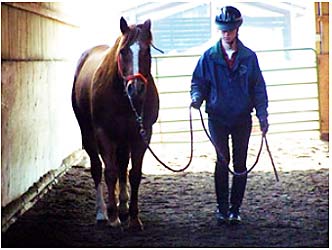
Good horse training is boring to watch. It looks like nothing is happening.
by Ron Meredith
Many people are impressed by training methods that are nothing more than a blatant series of attacks on the horse because they are dramatic to watch. However, physically dominating a horse
does not teach him anything. To train a horse, you must use mental strength, not physical strength.
Training horses starts with understanding how their minds work. You have to understand what is logical to the horse. The horse's mind does not work the same way as yours. They do not
associate events or a sequence of actions in the same way we reason that things are related. To train a horse, therefore, you have to understand how horse logic works and base your training on that.
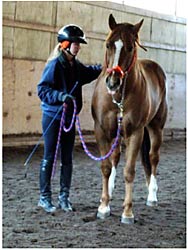 Horses are prey animals. They are in an undesirable position in
the food chain and they know this. Their eyes are on the outside of their heads so they can see danger coming from any direction. When we approach a horse, it has no way of knowing what our
actual intent is. It can only observe our actions and make a decision that it is safe to stay put or safer to flee. Horses are prey animals. They are in an undesirable position in
the food chain and they know this. Their eyes are on the outside of their heads so they can see danger coming from any direction. When we approach a horse, it has no way of knowing what our
actual intent is. It can only observe our actions and make a decision that it is safe to stay put or safer to flee.
When a large cat approaches a group of gazelles as a hunter, the
whole herd will start running and try to escape until one of them is killed. Once its hunt has been successful, the cat's tail goes down
and its muscles relax. Now it can pick up its kill and walk directly through the herd and the gazelles will just go on grazing. The cat's
body language has changed from a tense alertness that telegraphs the message "there is a hunter among us" to a more relaxed, non
-threatening posture that merely says "there is a cat walking among us" and the herd responds accordingly.
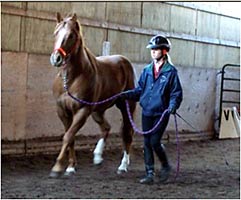 So your first communication task in training is to get the
horse to quietly accept you as a "cat walking in the herd" rather than as a "cat hunting within the herd." From a horse logical viewpoint, you do not want to be seen as an
attacking predator. Your next communication task, once the horse has quietly accepted you into its "herd," is to be the horse in control of the herd. Stallions do not run their
herds. All they are concerned with is who gets the next mare. The lead mare controls the herd and makes the decisions. She controls the herd through body language
that the other horses clearly understand. So your first communication task in training is to get the
horse to quietly accept you as a "cat walking in the herd" rather than as a "cat hunting within the herd." From a horse logical viewpoint, you do not want to be seen as an
attacking predator. Your next communication task, once the horse has quietly accepted you into its "herd," is to be the horse in control of the herd. Stallions do not run their
herds. All they are concerned with is who gets the next mare. The lead mare controls the herd and makes the decisions. She controls the herd through body language
that the other horses clearly understand.
At Meredith Manor, we get a horse to accept us as part of its "herd" and then we use body
language to get and keep its attention and to establish ourselves as the lead mare. We first use horse body language to play with the horse, then we use body language to get and keep the
horse's attention. Now we can add body language that creates a corridor of pressures that start to shape the horse's behavior. We create the desired shapes on the ground, then we transfer the
concept of corridors and shapes into our under saddle work. When done correctly, the entire system is very logical to the horse. There is no need for physical restraints or physical punishment
and the horse never feels "attacked."
Let me give you an example of how myth understandings about training happen when people
substitute human logic for horse logic. When a horse is scared or upset, it tenses and its head goes
up. Human logic says that to create the desired shape (a lower head carriage), all you have to do is
tie the horse's head down until the horse "understands." However, if the horse is tense because the
training methods were scaring or confusing it, this will only make the problem worse. From a horse
logical standpoint, the tie down is only another threat or attack. If the trainer's techniques were horse logical in the first place so that the horse remained relaxed, its head and neck would
eventually have the desired shape without the need for mechanical aids.
People who train by presenting the horse with a task then punishing the animal in some way when it
doesn't "get it" are on the wrong track. They think they are teaching the horse a lesson. But the
horse understands their "correction" only as an attack, a threat. No real learning takes place. By
fighting with a horse, the only thing you are teaching it is that the biggest, baddest one wins. You give the horse no clues about how to do things methodically and logically.
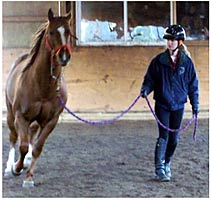 It is also important for trainers to realize that horses do not
understand or recognize human feelings. But our human feelings often create conflicts for us and our horses. If we don't plan our actions ahead when training, our actions will be
guided by feelings and instincts. Since man is a natural predator with an instinct for combat, the very first thing young males often do when frustrated is to fight. And the more
scared they are, the more willing they are to fight. When people make a big fuss in front of others, posturing about how they are handling this big, dangerous horse, very often it is
because they are afraid you are going to realize they are not really in control. It is also important for trainers to realize that horses do not
understand or recognize human feelings. But our human feelings often create conflicts for us and our horses. If we don't plan our actions ahead when training, our actions will be
guided by feelings and instincts. Since man is a natural predator with an instinct for combat, the very first thing young males often do when frustrated is to fight. And the more
scared they are, the more willing they are to fight. When people make a big fuss in front of others, posturing about how they are handling this big, dangerous horse, very often it is
because they are afraid you are going to realize they are not really in control.
Training is just like swallowing a big ball of string. It would be impossible to swallow it all at once.
But if you eat it an inch at a time, break the task down into really small bits, it is easy. Getting the
horse's attention is the first bite of the string we call training. Most of the “mythunderstandings”
about training come about because people try to swallow too big a chunk of string. You must go
bit by bit, using a methodical series of actions to get the horse's attention and direct the horse's
attention without threatening or attacking him. Training a horse involves dominating him mentally, not physically. And you must systematically introduce new shapes or tasks to him in a way that is
logical to the horse according to his natural instincts rather than your human instincts and logic.
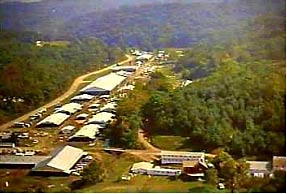 Meredith Manor International Equestrian Centre Meredith Manor is an equestrian trade school
dedicated entirely to producing professional riders, trainers, instructors, and farriers for the horse industry. All programs and courses are designed specifically to prepare you for a
successful equine career. Our programs range in length from 3 to 18 months, and our students spend 6 hours a day in Meredith Manor International Equestrian Centre Meredith Manor is an equestrian trade school
dedicated entirely to producing professional riders, trainers, instructors, and farriers for the horse industry. All programs and courses are designed specifically to prepare you for a
successful equine career. Our programs range in length from 3 to 18 months, and our students spend 6 hours a day in
primarily hands-on, skill based classes with
additional time spent in the barns and with the horses. Students don't have to excel in academic, classroom based classes to be successful in our
programs, but they must have a passion for horses and a dedication to having a successful equestrian career. Meredith Manor's name and reputation are known by serious horse people
throughout the world. Students from the ages of seventeen to sixty-three have attended the School from every state and many foreign countries. Meredith Manor strives to provide a climate of
learning in which each student may identify and accomplish his or her goals. We have continuously
researched the horse industry, designed the facilities, and developed the educational programs that
will give our students the training, experience, and confidence needed to have successful, life-long careers with horses!
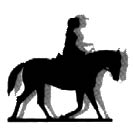 Ron Meredith has over forty years' experience as president of the school
and has developed it from its humble beginnings of six students in 1963 to its current world class level. Because of his outstanding contributions to the
horse industry and specifically to equestrian education, he has received a number of distinctive recognitions including an Honorary Doctorate of
Equestrian Studies. Dr. Meredith has held seven AHSA judges' cards and has trained top level horses and riders in the cutting and reining world. Ron Meredith has over forty years' experience as president of the school
and has developed it from its humble beginnings of six students in 1963 to its current world class level. Because of his outstanding contributions to the
horse industry and specifically to equestrian education, he has received a number of distinctive recognitions including an Honorary Doctorate of
Equestrian Studies. Dr. Meredith has held seven AHSA judges' cards and has trained top level horses and riders in the cutting and reining world.
Contact:
Meredith Manor International Equestrian Centre
147 Saddle Lane
Waverly, West Virginia 26184
Phone: 800-679-2603
Email: info@meredithmanor.edu
Website: www.meredithmanor.edu/
|
 |
|
To advertise your horse product or service, contact Ann
|
 |
|
InfoHorse.com, Horse Information Lives Here ® 12/21/2025
Contact Us to Advertise to over a million Horse Owners.
All images and content Copyright© 2012 by InfoHorse.com, Equusite.com.
Horse Owners are Dog Owners; Dog Product Information dognowner.com
|
|
|
Articles, Academic Schools, Arena Maintenance, Animal Communicators, Barns, Barn and Accessories, Barn Equipment and Tractors, Breast Collars, Grooming Products for Horses, Hay Feeders, Horse Blankets, Horse Books, Horse Videos, Horse Breeders, Horse Camping Gear, Career Schools, Carts and Buggies, Horse Training Clinicians, Equestrian Clothing, Dogs and Puppies, Horse Fencing, Western Art & Furniture, Horse Property for Sale, Horse Products For Sale, Fly Control, Foal Care, Horse Footings, Horse Gifts, Horse Health and Nutrition, Hoof and Leg, Horse Insurance, John Lyons Certified Trainers, Equine Lawyers, Leather Care, Links, Horse Property, Horse Photography, Portable Horse Stalls, Arenas and Roundpens, Horse Riding Schools, Horse Schools, Safety Products, Services for Horses, Horse Trailers, Horse Shipping, Horse Skin Coat Care, Horse Software, Specialty Trainers, Horse Summer Camps, Tack, Horse Trainers, Treats and Snacks, Truck Accessories, Trucks, Horse Vacations, Western Lifestyle, jewelry
|
|
|
|